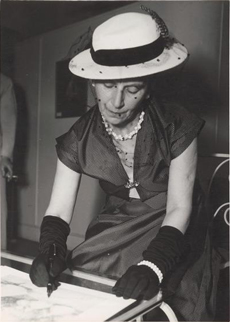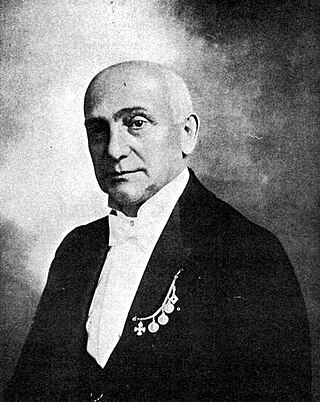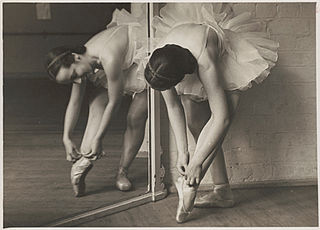
Dame Ninette de Valois was an Irish-born British dancer, teacher, choreographer, and director of classical ballet. Most notably, she danced professionally with Serge Diaghilev's Ballets Russes, later establishing the Royal Ballet, one of the foremost ballet companies of the 20th century and one of the leading ballet companies in the world. She also established the Royal Ballet School and the touring company which became the Birmingham Royal Ballet. She is widely regarded as one of the most influential figures in the history of ballet and as the "godmother" of English and Irish ballet.
The Cecchetti method is variously defined as a style of ballet and as a ballet training method devised by the Italian ballet master Enrico Cecchetti (1850–1928). The training method seeks to develop essential skills in dancers as well as strength and elasticity. Cecchetti-trained dancers are commonly found in ballet and other dance companies throughout the world.

The Royal Academy of Dance (RAD) is a UK-based examination board specialising in dance education and training, with an emphasis on classical ballet. The RAD was founded in London, England in 1920 as the Association of Teachers of Operatic Dancing, and was granted a Royal Charter in 1935. Queen Camilla is patron of the RAD, and Darcey Bussell was elected to serve as president in 2012, succeeding Antoinette Sibley who served for 21 years.

Dame Marie Rambert, Mrs Dukes DBE was a Polish-born English dancer and pedagogue who exerted great influence on British ballet, both as a dancer and teacher.
Maude Lloyd was a South African ballet dancer and teacher who immigrated to England and became an important figure in early British ballet as a founding member of Ballet Rambert. She had a significant second career as a dance critic, writing with her husband under the nom de plume Alexander Bland.

Dame Alicia Markova DBE was a British ballerina and a choreographer, director and teacher of classical ballet. Most noted for her career with Sergei Diaghilev's Ballets Russes and touring internationally, she was widely considered to be one of the greatest classical ballet dancers of the twentieth century. She was the first British dancer to become the principal dancer of a ballet company and, with Dame Margot Fonteyn, is one of only two English dancers to be recognised as a prima ballerina assoluta. Markova was a founder dancer of the Rambert Dance Company, The Royal Ballet and American Ballet Theatre, and was co-founder and director of the English National Ballet.

The Royal Ballet is a British internationally renowned classical ballet company, based at the Royal Opera House in Covent Garden, London, England. The largest of the five major ballet companies in Great Britain, the Royal Ballet was founded in 1931 by Dame Ninette de Valois. It became the resident ballet company of the Royal Opera House in 1946, and has purpose-built facilities within these premises. It was granted a royal charter in 1956, becoming recognised as Britain's flagship ballet company.

The Royal Ballet School is a British school of classical ballet training founded in 1926 by the Anglo-Irish ballerina and choreographer Ninette de Valois. The school's aim is to train and educate outstanding classical ballet dancers, especially for the Royal Ballet and the Birmingham Royal Ballet.
Vera Volkova (Russian: Bepa Boлкoвa; was a Russian ballet dancer and expatriate dance teacher.

Enrico Cecchetti was an Italian ballet dancer, mime, and founder of the Cecchetti method. The son of two dancers from Civitanova Marche, he was born in the costuming room of the Teatro Tordinona in Rome. After an illustrious career as a dancer in Europe, he went to dance for the Imperial Ballet in St. Petersburg, Russia, where he further honed his skills. Cecchetti was praised for his agility and strength in his performances, as well as his technical abilities in dance. By 1888, he was widely accepted as the greatest ballet virtuoso in the world.
Dame Catherine Margaret Mary Scott, was a South African-born pioneering ballet dancer who found fame as a teacher, choreographer, and school administrator in Australia. As the first director of the Australian Ballet School, she is recognised as one of the founders of the strong ballet tradition of her adopted country.
Sir Peter Wright CBE is a British ballet teacher, choreographer, director and former professional dancer. He worked as a choreographer and as the artistic director of Birmingham Royal Ballet, a classical ballet company based in Birmingham, England. On retiring from the company in 1995, he was bestowed the honorary title of director laureate of the company.

Dame Beryl Elizabeth Grey was a British ballet dancer.
Maryon Lane was a South African ballet dancer who became well known in Britain as a ballerina of the Sadler's Wells Theatre Ballet and as a soloist with the Royal Ballet.
John Field was an English ballet dancer, choreographer, director and teacher. He was a renowned member of the Vic-Wells Ballet and Sadler's Wells Theatre Ballet and was also artistic director of the La Scala Theatre Ballet.
Rambert is a leading British dance company. Formed at the start of the 20th century as a classical ballet company, it exerted a great deal of influence on the development of dance in the United Kingdom, and today, as a contemporary dance company, continues to be one of the world's most renowned dance companies. It has previously been known as the Ballet Club, and the Ballet Rambert.

Mona Inglesby , was a British ballet dancer, choreographer, director of the touring company International Ballet, and the person who saved the Sergeyev Collection for posterity.
The Camargo Society was a London society which created and produced ballet between 1930 and 1933, giving opportunity to British musicians, choreographers, designers and dancers. Its influence was disproportionate to its short life. Dame Ninette de Valois, founder of The Royal Ballet, saw it as "having done much for the cause of English ballet", and Encyclopædia Britannica Online credits it with "keeping ballet alive in England during the early 1930s". The society was named after the eighteenth-century French dancer Marie Anne de Cupis de Camargo.

Rachel Cameron was an Australian ballet dancer and teacher. She was one of the leading dancers in early Australian ballet in the 1940s, performing with the Borovansky and Kirsova ballet companies, and was one of the first ballet dancers in Australia to reach the rank of principal. After emigrating to Great Britain she was an inspirational educator of ballet teachers at the Royal Academy of Dance in London for over forty years. In 2010, she received the Royal Academy of Dance's prestigious Queen Elizabeth II Coronation Award in recognition of her outstanding services to ballet.










